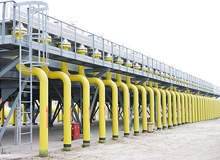
The West-East Gas Pipeline Project (WEPP) is one of the major natural gas transmission projects intended for the development of the western regions in China.
The project involves construction of four gas pipelines connecting the eastern markets of China with the western resources to allow mutual and sustainable development.
The pipelines travel along varied terrains such as plateaus, mountains, deserts and rivers in order to connect the Tarim Basin in Xinjiang Autonomous Region and Turkmenistan with the Yangtze Delta and Pearl Delta regions.
The pipeline project is being developed by PetroChina West-East Gas Pipeline Company, a subsidiary of PetroChina.
The state-owned largest oil and gas producer China National Petroleum Corporation (CNPC) owns the majority stake in PetroChina.
The first west-east gas pipeline (WEPP I) opened in December 2004. Construction on the second pipeline (WEPP II) started in February 2008 and was completed in December 2012. Groundbreaking for the third pipeline (WEPP III) took place in October 2012 and the pipeline was constructed by August 2014. WEPP IV is still in the planning stage.
China’s pipeline routes
The western section links Xinjiang to Shaanxi and the eastern section connects Shaanxi and Shanghai. It also connects to Shaan-Jing pipeline.
The WEPP II has a total length of 8,704km and travels through 15 provinces. It has an eastern and western section, and eight branches. It is the longest natural gas pipeline in the world. It originates at Horgos in Xinjiang Uygur Autonomous Region and terminates at the Hong Kong Special Administrative Region after traversing Shanghai and Guangzhou.
The eastern section runs between Guangzhou and Zhongwei. It reaches Hong Kong and Shanghai in the south. The western section runs from Horgos to Zhongwei in Ningxia Hui autonomous region.
A 4,978km eastern section of the WEPP II commenced operations in June 2011. It runs from Horgas to Shanghai in the east and to Guangzhou in the south.
The WEPP II is estimated to cost $22bn. Its transmission capacity is 30bcm and a minimum lifespan of 30 years. It links about ten major pipelines in the country.
It is interconnected and runs parallel to WEPP I. It links the second Shaan-Jing gas pipeline through the Jingbian cross-link station. The sections are also connected to the Central Asia-China gas pipeline.
The 7,378km WEPP III was laid between south eastern China and the west from Xinjiang autonomous region to the Guangdong province. The pipeline includes a 5,220km-long main line and eight branches. The main line originates at Horgos and terminates at Fuzhou of Fujian Province.
The WEPP III is designed to deliver 30bcm annually at 10-12Mpa.
The WEPP IV is planned to connect the Sino-Myanmar natural gas pipeline with the Sichuan gas fields or the Tarim basin.
Western China’s reserves / resources
Xinjiang in west China has a major natural gas resource in the Tarim Basin. The 560,000km² basin has gas resources of approximately 8.4 billion cubic metres with proven reserves of 532.9 billion cubic metres and prospective reserves of one trillion cubic metres.
Roughly 70% of the total electricity is sourced from coal in China. The WEPP II will replace burning of about 76.8 million tons of coal a year used for generating electricity. This is expected to reduce approximately 130 million tons of CO2 and 1.44 million tons of SO2 emissions.
Construction and infrastructure of the West-East Gas Pipeline project
The WEPP I construction was started in 2002 and completed in 2004. It used X-70 steel pipeline of 1,016mm diameter. Initially designed with a 12 billion cubic metre (bcm) capacity of natural gas per annum, it started commercial supply in 2005.
In December 2009, the capacity was increased to 17bcm by upgrading its existing eight compressor stations and installing ten new additional stations. GE Oil and Gas supplied the equipment for WEPP I.
The WEPP II used the X-80 steel pipeline of 1,219mm diameter. Construction of its western section began in February 2008, while work on the eastern section began in February 2009. The western section was completed in December 2009.
The Zhongwei-Huangpi and Zaoyang-Shiyan portions of the eastern section were completed by December 2010. The entire WEPP II was completed in December 2012.
Construction of the WEPP III was started in October 2012 and was completed in 2014. The pipeline project attracted an investment of $19.9bn.
Technology used in building WEPP
The WEPP I is equipped with Nortel IP-based networking for multimedia and voice communications along its length. In June 2010, Honeywell was selected to provide safety and control systems for the WEPP II pipeline. The company installed an experion process knowledge system (PKS) and safety manager solutions for the WEPP II project.
Contractors
In May 2011, GE Oil and Gas was awarded a $100m contract to supply nine electric motor-driven compressors and six PGT25+ gas turbine-driven compression trains for the eastern section of WEPP II. GE Oil and Gas had also installed compressor stations for WEPP I.
Elster-Instromet has been contracted to supply 70 sets of ultrasonic gas metering skids for the project. Converteam was contracted for providing nine variable speed drives systems for the WEPP II compressor trains supplied by GE.
In April 2011, Rolls-Royce was awarded a $65m contract to supply six RB211 gas turbine compressor packages to be installed along the eastern section of the WEPP II. The company supplied six similar units for the western section of WEPP line one.
The X-80 coil for manufacturing the WEPP II line and spiral submerged arc-welded pipes were supplied by China-based Shandong Shengli Steel Pipe, Baosteel, Maanshan Iron and Steel, and Taiyuan Iron and Steel.
GE Oil and Gas is the supplier of compression equipment of the boosting stations. In June 2010, Honeywell was contracted to manage the WEPP II operations.

